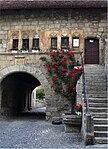Lake Neuchâtel (French: Lac de Neuchâtel [lak də nøʃɑtɛl]; Arpitan: Lèc de Nôchâtél; German: Neuenburgersee) is a lake primarily in Romandy, in the French-speaking part of Switzerland. The lake lies mainly in the canton of Neuchâtel, but is also shared by the cantons of Vaud, Fribourg, and Bern. It comprises one of the lakes in the Three Lakes Region (French: Pays des Trois-Lacs, German: Drei-Seen-Land), along with lakes Biel/Bienne and Morat/Murten.
With a surface of 218.3 km2 (84 sq mi), Lake Neuchâtel is the largest lake located entirely in Switzerland and the 59th largest lake in Europe. It is 38.3 km (23.8 mi) long and 8.2 km (5.1 mi) at its widest. Its surface is 429 metres (1,407 ft) above sea level, and the maximum depth is 152 metres (499 ft). The total water volume is 14.0 km3 (3.4 cu mi). The lake's drainage area is approximately 2,670 km2 (1,031 sq mi) and its culminating point is Le Chasseron at 1,607 metres (5,272 ft).In comparison to the Lake Geneva region, the Lake Neuchatel shoreline has experienced significant economic development with the completion of the regional motorway network. It is also known to have housed a Celtic agglomeration on pile-dwellings called La Tène and which gives its name to the second Iron Age.
The lake is fed by the rivers L'Orbe (called La Thielle or La Thièle locally, downstream of the city of Orbe), L'Arnon, L'Areuse, Le Seyon, and La Menthue, as well as by the Canal de la Broye. The Thielle Canal (French: Canal de la Thielle, German: Zihlkanal) drains the lake into Lake Biel and is part of regulation system for the lakes and the rivers of the Seeland region.
Lake Neuchâtel was the home of the now extinct species of deepwater trout Salvelinus neocomensis.










